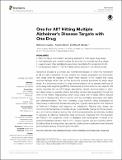Files in this item
One For All? Hitting multiple Alzheimer’s Disease targets with one drug
Item metadata
| dc.contributor.author | Hughes, Rebecca E. | |
| dc.contributor.author | Nikolic, Katarina | |
| dc.contributor.author | Ramsay, Rona Ruth | |
| dc.date.accessioned | 2016-04-26T10:30:03Z | |
| dc.date.available | 2016-04-26T10:30:03Z | |
| dc.date.issued | 2016-04-25 | |
| dc.identifier | 241962569 | |
| dc.identifier | c944ecd6-e5a9-4abe-8dfa-3b22ffdfba38 | |
| dc.identifier | 84966377266 | |
| dc.identifier | 000374817000002 | |
| dc.identifier.citation | Hughes , R E , Nikolic , K & Ramsay , R R 2016 , ' One For All? Hitting multiple Alzheimer’s Disease targets with one drug ' , Frontiers in Neuroscience , vol. 10 , 177 . https://doi.org/10.3389/fnins.2016.00177 | en |
| dc.identifier.issn | 1662-453X | |
| dc.identifier.uri | https://hdl.handle.net/10023/8677 | |
| dc.description | The authors thank the participants in COST Action CM1103 “Structure-based drug design for diagnosis and treatment of neurological diseases: dissecting and modulating complex function in the monoaminergic systems of the brain” for productive collaborations and COST for funding open access publication. | en |
| dc.description.abstract | Alzheimer’s Disease is a complex and multifactorial disease for which the mechanism is still not fully understood. As new insights into disease progression are discovered, new drugs must be designed to target those aspects of the disease that cause neuronal damage rather than just the symptoms currently addressed by single target drugs. It is becoming possible to target several aspects of the disease pathology at once using multi-target drugs. Intended as a introduction for non-experts, this review describes the key multi-target drug design approaches, namely structure-based, in silico, and data-mining, to evaluate what is preventing compounds progressing through the clinic to the market. Repurposing current drugs using their off-target effects reduces the cost of development, time to launch, and the uncertainty associated with safety and pharmacokinetics. The most promising drugs currently being investigated for repurposing to Alzheimer’s Disease are rasagiline, originally developed for the treatment of Parkinson’s Disease, and liraglutide, an antidiabetic. Rational drug design can combine pharmacophores of multiple drugs, systematically change functional groups, and rank them by virtual screening. Hits confirmed experimentally are rationally modified to generate an effective multi-potent lead compound. Examples from this approach are ASS234 with properties similar to rasagiline, and donecopride, a hybrid of an acetylcholinesterase inhibitor and a 5-HT4 receptor agonist with pro-cognitive effects. Exploiting these interdisciplinary approaches, public-private collaborative lead factories promise faster delivery of new drugs to the clinic. | |
| dc.format.extent | 10 | |
| dc.format.extent | 939996 | |
| dc.language.iso | eng | |
| dc.relation.ispartof | Frontiers in Neuroscience | en |
| dc.subject | Multi-target drugs | en |
| dc.subject | Alzheimer’s Disease | en |
| dc.subject | In silico | en |
| dc.subject | Datamining | en |
| dc.subject | Rational drug design | en |
| dc.subject | Repurposing | en |
| dc.subject | RB Pathology | en |
| dc.subject | RM Therapeutics. Pharmacology | en |
| dc.subject | Chemistry (miscellaneous) | en |
| dc.subject.lcc | RB | en |
| dc.subject.lcc | RM | en |
| dc.title | One For All? Hitting multiple Alzheimer’s Disease targets with one drug | en |
| dc.type | Journal item | en |
| dc.contributor.institution | University of St Andrews. School of Biology | en |
| dc.contributor.institution | University of St Andrews. Biomedical Sciences Research Complex | en |
| dc.identifier.doi | 10.3389/fnins.2016.00177 | |
| dc.description.status | Peer reviewed | en |
This item appears in the following Collection(s)
Items in the St Andrews Research Repository are protected by copyright, with all rights reserved, unless otherwise indicated.

